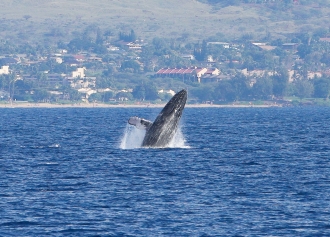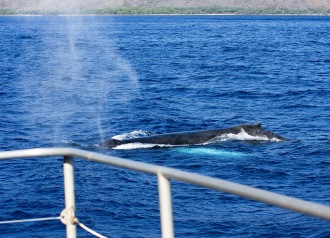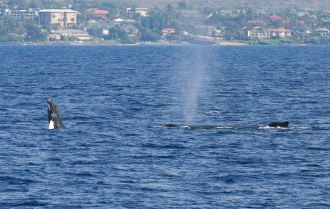
A Humpback whale calf breaches, seemingly jumping just for the sheer enjoyment. (19 Jan 2014)
(Click on image to see a larger version.)
I always look forward to this time of the year. No… I don’t mean Christmas or Chanukah: like many Kama’aina (long-time island residents), I celebrate the return of the North Pacific population of Humpback Whales to the warm coastal waters of Hawaii; more specifically, the shallows of Maui’s Ma’alaea Bay.

Following its mother’s example, a newborn Humpback calf gamely performs a more subdued breach as it’s mother splashes back into the water after performing her own breach. (19 Jan 2014)
(Click on image to see a larger version,)
The bay is the heart of the Hawaiian Islands Humpback Whale National Marine Sanctuary, which includes the shallow channel waters between Maui and the neighbor islands of Lana’i, Molokini and Kaho’olawe.
Because I live on a beach fronting the bay, I see and hear the “Humpies” day and night from mid-December until early May when the last stragglers head back to their feeding grounds in the colder nutrient-rich waters off Alaska, Russia and northern Japan. Each November I wait for reports of the first whale sitings in Maui’s waters, after which I book a season pass on a local whale boat, and wait impatiently for the first morning run in late December.

The flukes of a young Humpback whale disappear gracefully beneath the surface as it prepares for a deep flukes-up dive.
(19 Jan 2014)
Click on image to see a larger version.)
With my camera and gear snug in my backpack, I’m one of the first to board the whale boat, scrambling up the ladder to the flying bridge to claim my favorite spot: well out on the starboard rail, the best place for spotting a “blow” or a “breach” from a distance. I prefer the steeper angle on the water this perch affords because, whether the subject is close-in to the boat or at a distance, I get a good shooting angle looking down onto the subject.
As the captain and crew prepare to get under way, it’s time to get serious about the “shoot.” I carefully remove the dust cap from my reliable old Canon 40D, do likewise with the heavy tan-colored tube of the “L” series 300 mm zoom/telephoto lens, and quickly twist the two into one another with a satisfying “snap” of the 40D’s bayonet mount. As the boat’s engines rev on leaving its slip, I load the 16 GB memory card into its dedicated port on the camera body, set the lens’ image stabilizer, remove the lens’ dust cap, ensure that the UV filter is clean and screwed on snugly, and then check to see that the camera is safely secured to my shoulder harness.

A pair of males tussle with one another to win the attention of a receptive female (rolled over onto her side at left, her pectoral fin and a fluke exposed at the surface) as a tour boat passes by, careful to stay outside the 100-yard approach radius mandated by law.
(18 Jan 2014) (Click on image to view a larger version.)
For me, “The Whale Season” usually starts the last week of December: even though the first humpies are sighted in mid-October, we don’t begin to see them in significant numbers in Ma’alaea Bay until well after Christmas Day. I usually do twenty boat trips a season, saturdays and sundays until the middle of March, when the number of whales in the bay drops steadily until early May when the last whales leave for Alaskan waters.

Two members of a raucous, surface-active competition pod dive and chase madly after one another and the receptive female whose presence instigated the battle. (29 Dec 2013)
(To see a larger version, click on image.)
The first three trips were nothing special: I photographed a couple of uninteresting cow-and-calf pairs and some “blows” several hundred meters from the boat. But the fourth, fifth, sixth and seventh trips in January were great and hinted of better “shoots” to come. Here’s a few of the best shots from this season’s trips so far.

A mature Humpback warily passes close by my boat; its huge pectoral fins are the turquoise-colored underwater shadow seen just below and to the side of the whale. (29 Dec 2013)
(To see a larger version, click on image.)

A mature Humpback produces a loud trumpeting exhalation in combination with a plume of atomized seawater as it passes close by my whale boat. (29 Dec 2013)
(To see a larger version, click on the image.)
The photo above is interesting because Humpback whales usually don’t display this behavior in Hawaiian waters. It is usually associated with feeding and seen more commonly in frigid waters of the Alaskan feeding grounds.

A mature Humpback closes to within a few meters of my boat; on its back is a prominent scar, probably received during the struggles involved in a competition pod. (29 Dec 2013)
(To see a larger version, click on image.)

A newborn Humpback whale calf gamely attempts a few clumsy breaches as its mother cruises along just behind it, keeping a watchful eye on her rapidly-developing child. (19 Jan 2014)
(To view a larger version, click on image.)

A young Humpback calf, probably born a few weeks previous, performs a series of progressively more skillful breaches. Its mother trails behind, at right, just out of the picture. (19 Jan 2014)
(To see a larger version, click on image.)

A rare “double breach” performed by a cow and calf; mothers of newborn whales are often seen performing this and other behavior with their newborns, apparently teaching them to do “whale stuff.”
(19 Jan 2014) (To see a larger version, click on image.)

Following its mother’s example, a newborn calf gamely performs a more subdued breach as it’s mother crashes back into the water after performing her own breach. (19 Jan 2014)
(Click on image to see a larger version.)

A cow and calf pair. The mother is gently carrying her newborn on her rostrum (the protruding upper jaw). Young calves have relatively small lung capacity and so mothers must ensure they stay near the surface to make it easier for them to reach the surface for a breath. (11 Jan 2014) (Click on image to see a larger version.)
Check out the next blog post as “whale-watching season” moves into February, the busiest time of the migration.














